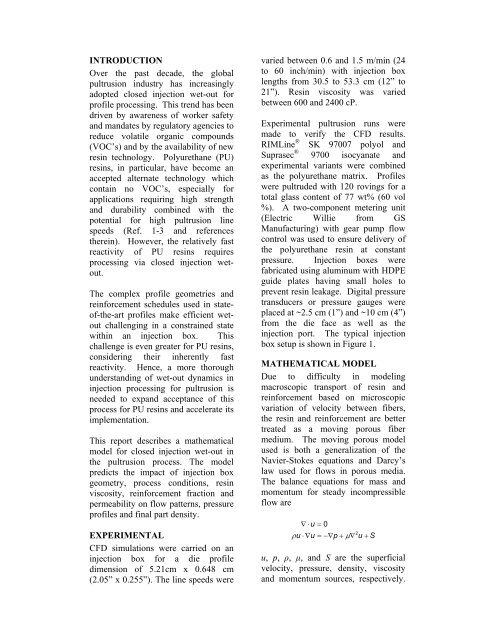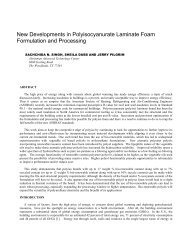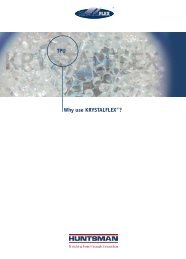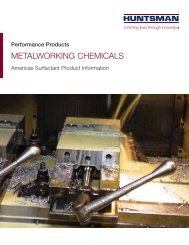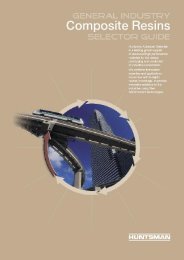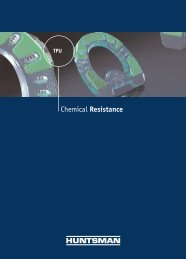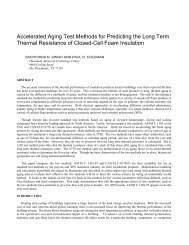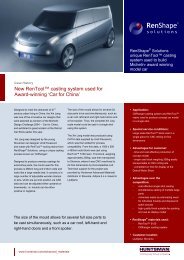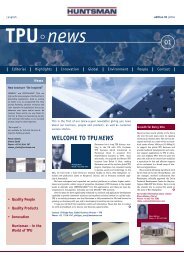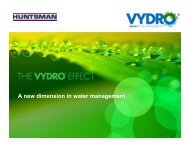CFD Modeling of the Closed Injection Wet-Out Process For Pultrusion
CFD Modeling of the Closed Injection Wet-Out Process For Pultrusion
CFD Modeling of the Closed Injection Wet-Out Process For Pultrusion
Create successful ePaper yourself
Turn your PDF publications into a flip-book with our unique Google optimized e-Paper software.
INTRODUCTION<br />
Over <strong>the</strong> past decade, <strong>the</strong> global<br />
pultrusion industry has increasingly<br />
adopted closed injection wet-out for<br />
pr<strong>of</strong>ile processing. This trend has been<br />
driven by awareness <strong>of</strong> worker safety<br />
and mandates by regulatory agencies to<br />
reduce volatile organic compounds<br />
(VOC s) and by <strong>the</strong> availability <strong>of</strong> new<br />
resin technology. Polyurethane (PU)<br />
resins, in particular, have become an<br />
accepted alternate technology which<br />
contain no VOC s, especially for<br />
applications requiring high strength<br />
and durability combined with <strong>the</strong><br />
potential for high pultrusion line<br />
speeds (Ref. 1-3 and references<br />
<strong>the</strong>rein). However, <strong>the</strong> relatively fast<br />
reactivity <strong>of</strong> PU resins requires<br />
processing via closed injection wetout.<br />
The complex pr<strong>of</strong>ile geometries and<br />
reinforcement schedules used in state<strong>of</strong>-<strong>the</strong>-art<br />
pr<strong>of</strong>iles make efficient wetout<br />
challenging in a constrained state<br />
within an injection box. This<br />
challenge is even greater for PU resins,<br />
considering <strong>the</strong>ir inherently fast<br />
reactivity. Hence, a more thorough<br />
understanding <strong>of</strong> wet-out dynamics in<br />
injection processing for pultrusion is<br />
needed to expand acceptance <strong>of</strong> this<br />
process for PU resins and accelerate its<br />
implementation.<br />
This report describes a ma<strong>the</strong>matical<br />
model for closed injection wet-out in<br />
<strong>the</strong> pultrusion process. The model<br />
predicts <strong>the</strong> impact <strong>of</strong> injection box<br />
geometry, process conditions, resin<br />
viscosity, reinforcement fraction and<br />
permeability on flow patterns, pressure<br />
pr<strong>of</strong>iles and final part density.<br />
EXPERIMENTAL<br />
<strong>CFD</strong> simulations were carried on an<br />
injection box for a die pr<strong>of</strong>ile<br />
dimension <strong>of</strong> 5.21cm x 0.648 cm<br />
(2.05 x 0.255 ). The line speeds were<br />
varied between 0.6 and 1.5 m/min (24<br />
to 60 inch/min) with injection box<br />
lengths from 30.5 to 53.3 cm (12 to<br />
21 ). Resin viscosity was varied<br />
between 600 and 2400 cP.<br />
Experimental pultrusion runs were<br />
made to verify <strong>the</strong> <strong>CFD</strong> results.<br />
RIMLine ® SK 97007 polyol and<br />
Suprasec ®<br />
9700 isocyanate and<br />
experimental variants were combined<br />
as <strong>the</strong> polyurethane matrix. Pr<strong>of</strong>iles<br />
were pultruded with 120 rovings for a<br />
total glass content <strong>of</strong> 77 wt% (60 vol<br />
%). A two-component metering unit<br />
(Electric Willie from GS<br />
Manufacturing) with gear pump flow<br />
control was used to ensure delivery <strong>of</strong><br />
<strong>the</strong> polyurethane resin at constant<br />
pressure. <strong>Injection</strong> boxes were<br />
fabricated using aluminum with HDPE<br />
guide plates having small holes to<br />
prevent resin leakage. Digital pressure<br />
transducers or pressure gauges were<br />
placed at ~2.5 cm (1 ) and ~10 cm (4 )<br />
from <strong>the</strong> die face as well as <strong>the</strong><br />
injection port. The typical injection<br />
box setup is shown in Figure 1.<br />
MATHEMATICAL MODEL<br />
Due to difficulty in modeling<br />
macroscopic transport <strong>of</strong> resin and<br />
reinforcement based on microscopic<br />
variation <strong>of</strong> velocity between fibers,<br />
<strong>the</strong> resin and reinforcement are better<br />
treated as a moving porous fiber<br />
medium. The moving porous model<br />
used is both a generalization <strong>of</strong> <strong>the</strong><br />
Navier-Stokes equations and Darcy s<br />
law used for flows in porous media.<br />
The balance equations for mass and<br />
momentum for steady incompressible<br />
flow are<br />
u<br />
0<br />
2<br />
u u p u S<br />
u, p, , , and S are <strong>the</strong> superficial<br />
velocity, pressure, density, viscosity<br />
and momentum sources, respectively.


